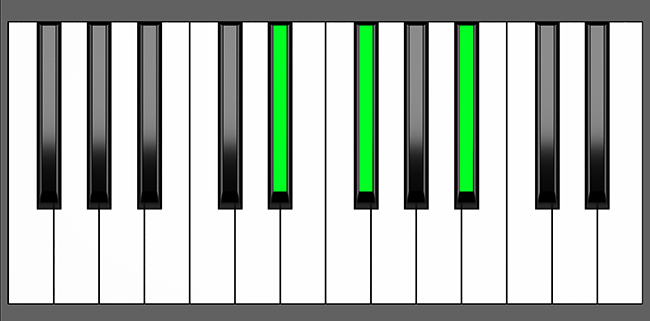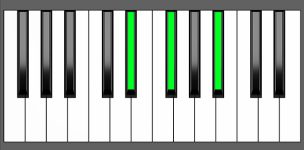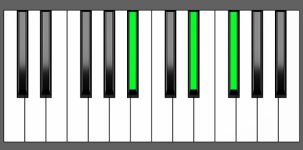Piano Diagram of D# min in Root Position

The D# minor chord is the minor triad built upon the D-sharp key. It is built by combining the Root note (D#), the minor 3rd (F#), and the 5th (A#) notes from the D# minor scale.
Structure of D# minor
Notes |
|---|
| D#, F#, A# |
Intervals |
|---|
| R, m3, 5 |
Fingers Position
Left Hand |
|---|
| 4, 2, 1 |
Right Hand |
|---|
| 1, 2, 4 |
D# minor Chord Inversions
The D# minor chord has a total of 2 inversions:
| Root Position: | D# | F# | A# |
| 1st Inversion: | F# | A# | D# |
| 2nd Inversion: | A# | D# | F# |
Piano Keyboard Diagrams
Music Theory and Harmony of D# minor
What are Minor Chords?
Minor chords are one of the two most important types of chords in music, along with the major chord. Minor chords are triads that have a slightly different sound from major chords. They have a darker and more melancholic sound compared to major chords, which have a brighter and more uplifting sound. The difference lies in the 3rd note of the chord – minor chords use a minor 3rd while major chords use a major 3rd.
Despite their darker sound, minor chords are still considered stable and consonant chords. This means that they do not create a sense of tension or dissonance that requires resolution, unlike some other types of chords such as dominant 7th chords or diminished chords.
Building the D# minor Chord: Different Approaches
Starting from the D# minor scale
A minor chord is made up of three notes: Root, minor 3rd, and 5th of a minor scale.

To build a minor chord, you can apply the formula R, m3, 5 using these step-by-step instructions:
- Begin with the Root note, D#.
- Pick the minor 3rd F#.
- Finally, add the 5th interval, which is A#.
This formula can be applied to any major scale to create a minor chord with a different root note.
by Combining Intervals
A minor chord is created by combining two specific intervals: a minor 3rd and a major 3rd.
m3 + 3 = minor Chord
To form a D# minor chord, begin with the root note D# and add a minor 3rd interval. This interval consists of three half-steps, so count up three half-steps from the root note D# to find the note F#.
Next, add a major 3rd interval to the note F#. This interval consists of four half-steps, so count up four half-steps from the note F# to find the note A#.
These three notes – D#, F#, and A# – together create the D# minor chord. So, the D# minor chord is made up of a minor 3rd interval between D# and F#, and a major 3rd interval between F# and A#.
It’s worth noting that this method is not the easiest way to create a minor chord, but it’s a commonly used approach.
How to Use D# min in a Chord Progression
Harmonic functions are fundamental concepts in music theory that describe the roles played by chords within a specific key and context. In Western music, there are seven primary harmonic functions, which correspond to the notes of the diatonic scale. The most important functions are the tonic, dominant, and subdominant, with major chords denoted by capitalized Roman numerals and minor chords by lowercase ones.
To gain a better understanding of the harmonic functions of D# min in various scales, the tables below show the natural minor scales and their corresponding relative major scales for all keys that include a D# minor chord in different scale degrees. These tables offer a helpful guide to understanding how chords function harmonically and relate to one another in different keys.
Keys with many accidentals, such as D# minor, A# minor, and G# minor, can be challenging to play. Musicians often prefer to use their enharmonic equivalent keys, such as Eb minor, Bb minor, and Ab minor, respectively, which have fewer accidentals and are easier to handle. This is particularly true in keys where the number of flats is lower. Therefore, playing the enharmonic equivalent chords in these keys can be a more practical choice.
on Natural minor Scales
| Minor Scales | i | ii | III | iv | v | VI | VII |
|---|---|---|---|---|---|---|---|
| D# | D# min | E# dim | F# Maj | G# min | A# min | B Maj | C# Maj |
| A# | A# min | B# dim | C# Maj | D# min | E# min | F# Maj7 | G# Maj |
| G# | G# min | A# dim | B Maj | C# min | D# min | E Maj | F# Maj |
- Tonic chord in D# minor
- Subdominant chord in A# minor
- Dominant chord in G# minor
on Major Scales
| Major Scales | I | ii | iii | IV | V | vi | vii |
|---|---|---|---|---|---|---|---|
| C# | C# Maj | D# min | E# min | F# Maj | G# Maj | A# min | B# dim |
| B | B Maj | C# min | D# min | E Maj | F# Maj | G# min | A# dim |
| F# | F# Maj | G# min | A# min | B Maj | C# Maj | D# min | E# dim |
- Supertonic chord in C# Major
- Mediant chord in B Major
- Submediant chord in F# Major
D# minor chord Function in Major and Minor Keys
Understanding Scale Degrees
When we create chords from a scale, each note in the scale is given a specific degree that reflects its position in the scale. In the diatonic scales, there are seven degrees, and each degree plays a unique role in the overall harmony of the scale.
- The Tonic, also known as the I degree, establishes the fundamental tonal center of the scale and serves as a stable foundation for the melody or harmony.
- The Supertonic, or II degree, acts as a passing note between the tonic and other scale degrees.
- The Mediant, positioned halfway between the tonic and dominant, helps establish whether the scale is major or minor and provides a sense of harmonic balance.
- The Subdominant, or IV degree, serves as a complementary harmony to the dominant.
- The Dominant, or V degree, generates tension and creates a sense of expectation.
- The Submediant, or VI degree, acts as a transitional point between the dominant and tonic.
- Finally, the Leading tone, or VII degree, located one half step below the tonic, creates a strong sense of tension and a desire to resolve to the tonic.
D# min in D# Minor
As the tonic chord in the D# minor scale, the D# minor chord provides a stable and foundational harmonic center for chord progressions. This chord serves as the “home base” of the entire harmony.
| i | ii | III | iv | v | VI | VII |
| D# min | E# dim | F# Maj | G# min | A# min | B Maj | C# Maj |
D# minor chord Progressions as i degree
The following chord progressions are examples of how the D# minor chord can serve as the tonic chord (i degree) in two different chord progressions.
i VI VII
| i | VI | VII |
| D# min | B Maj | C# Maj |
i III VII VI
| i | III | VII | VI |
| D# min | F# Maj | C# Maj | B Maj |
D# min in A# Minor
The D# minor chord can also appear as the subdominant chord in the key of A# minor. Specifically, it can be found on the fourth degree of the A# minor scale.
| i | ii | III | iv | v | VI | VII |
| A# min | B# dim | C# Maj | D# min | E# min | F# Maj | G# Maj |
D# minor Chord Progressions as iv degree
The following chord progressions feature the D# minor chord as the subdominant (iv degree):
i iv III VII
| i | iv | III | VII |
| A# min | D# min | C# Maj | G# Maj |
i iv VI v
| i | iv | VI | v |
| A# min | D# min | F# Maj | E# min (F min) |
D# min in G# Minor
The D# minor chord can also appear as the dominant chord in the G# minor scale. Specifically, it can be found on the fifth degree of the scale.
| i | ii | III | iv | v | VI | VII |
| G# min | A# dim | B Maj | C# min | D# min | E Maj | F# Maj |
D# minor as v degree – Chord Progressions
If you want to hear how the D# minor chord sounds as the dominant (V) chord in the G-sharp minor scale, try playing the following chord progressions.
i iv VI v
| i | iv | VI | v |
| G# min | C# min | E Maj | D# min |
i v VI VII
| i | v | VI | VII |
| G# min | D# min | E Maj | F# Maj |
i VI v iv
| i | VI | v | iv |
| G# min | E Maj | D# min | C# min |
D# min in C# Major
In addition to its positions in natural minor scales, the D# minor chord can also be found in major keys. For example, in the key of C-sharp major, the D# minor chord serves as the supertonic chord, found on the second degree of the scale. A supertonic minor chord creates a sense of anticipation or expectation, as it usually leads to the dominant or subdominant chords.
| I | ii | iii | IV | V | vi | vii |
| C# Maj | D# min | E# min | F# Maj | G# Maj | A# min | B# dim |
D# minor Chord Progressions as ii degree
Try playing the following chord progressions to better understand how the D# minor chord functions as the supertonic (ii) chord in the key of C# major.
ii V I
| ii | V | I |
| D# min | G# Maj | C# Maj |
I IV ii V iii vi ii V
| I | IV | ii | V | iii | vi | ii | V |
| C# Maj | F# Maj | D# min | G# Maj | E# min | A# min | D# min | G# Maj |
D# min in B Major
The D# minor chord can serve as the mediant (iii) chord in the key of B major, which means it can be found on the third degree of the B major scale. The mediant minor chord is often used as a moment of temporary tonal ambiguity or a departure from the established tonality before returning to the tonic chord.
| I | ii | iii | IV | V | vi | vii |
| B Maj | C# min | D# min | E Maj | F# Maj | G# min | A# dim |
D# minor Chord Progressions as iii degree
To better understand how the D# minor chord serves as the mediant (iii) in the B major scale, you can try playing the following chord progressions.
I iii IV V
| I | iii | IV | V |
| B Maj | D# min | E Maj | F# Maj |
I iii ii V
| I | iii | ii | V |
| B Maj | D# min | C# min | F# Maj |
I iii vi V
| I | iii | vi | IV |
| B Maj | D# min | G# min | E Maj |
D# min in F# Major
The D# minor chord can be found on the sixth degree of the F# major scale, serving as the submediant chord. The submediant chord is often characterized by a sense of relaxation and stability in a chord progression.
| I | ii | iii | IV | V | vi | vii |
| F# Maj | G# min | A# min | B Maj | C# Maj | D# min | E# dim |
D# minor as vi degree – Chord Progressions
You can explore the sound of D# minor as the submediant chord in the key of F# major by playing the following chord progressions:
I iii vi V
| I | iii | vi | V |
| F# Maj | A# min | D# min | C# Maj |
I vi ii V
| I | vi | ii | V |
| F# Maj | D# min | G# min | C# Maj |
I IV ii V iii vi ii V
| I | IV | ii | V | iii | vi | ii | V |
| F# Maj | B Maj | G# min | C# Maj | A# min | D# min | G# min | C# Maj |
Alternative Names for D# minor
- D#-
- Re#-
- D#m
- Re# m
- D# min
- D#-moll
- Re# min
- D# minor
- D sharp minor


